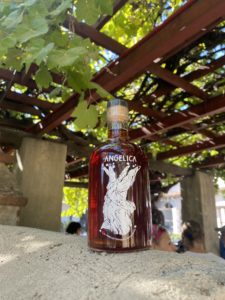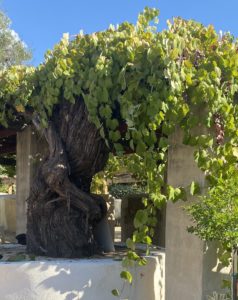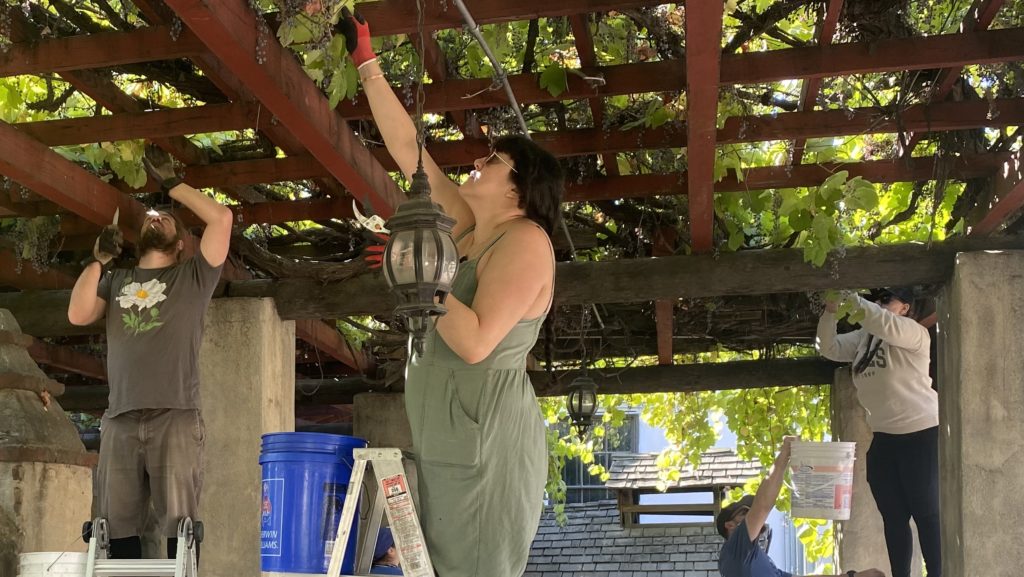With church bells above her head and gravestones at her feet, Amy Luftig harvests grapes at Mission San Gabriel Arcángel, home to perhaps the oldest-producing vine in California. The unique setting — part vineyard, part shrine — fills the vintner with serenity.
“The solemnity of the place itself is very touching,” said Luftig, co-owner of Angeleno Wine Company. “It has that really beautiful, very calming environment.”
The harvest was part of a recent winemaking venture between the mission and the three founding wineries of the Los Angeles Vintners Association: Angeleno Wine Company, Byron Blatty Wines, and Cavaletti Vineyards. By producing “Angelica,” a sweet fortified wine once crafted by the Franciscan friars, the partners aim to revive the missionaries’ tradition as well as the local wine industry. On Nov. 3, members from the vintners’ wine clubs arrived with shears, step ladders, and enough energy to reap around 400 pounds of fruit.
“I think it’s pretty great because it’s a vineyard in Los Angeles County,” said wine club member Courtney Estorga. “I actually grew up around this area so this is kind of cool to pick grapes where my cousin got married.”
As volunteers snipped off the small dark grapes, Father Paschal Amagba, CMF, pastor of Mission San Gabriel, came by to thank them for their efforts. Amagba said he sees a glimpse of the divine in the centuries-old plant.
“It is more than a grape, more than a vine, it’s God’s handiwork,” Amagba said. “For me, it is a sign of life and the connectivity of the first people here to all of us here now. … Even when I touch it, I think wow, maybe this small bit was touched by Junípero Serra.”

St. Junípero Serra, a Spanish priest, did in fact bring vine cuttings to California and is credited with the first planting at Mission San Diego de Alcalá. Around 1775, friars under his leadership at Mission San Gabriel planted the still thriving “Mother Vine.” The subsequent grapes were used to make wine for Mass and trade. However, after many profitable years, the missions were secularized, the grapes fell out of favor and the vine was abandoned.
That changed in 2020, when mission staff wanted to propagate new vines at the front of the property and asked the wine association for help. Upon seeing the grapes, the excited vintners had other ideas.
“They asked if they could take the grapes and I said ‘yes please’ because they make a mess,” said Terri Huerta, director of Mission Development and Communications. “It has been a great collaboration, really a way to continue the legacy of winemaking that the missions introduced here.
“It’s part of the history, we want to sustain it.”
A recipe found in old mission records guided the vintners in their version of Angelica. No money changes hands between the mission and the vintners. However, Huerta said projects like this allow the church to partner with the community and introduce itself to people who otherwise might never visit.
When newcomers enter the mission courtyard, they’ll see grapevines running along a pergola then down to the now-labeled and fabled Mother Vine. Those responsible for its planting remain a mystery but they were seemingly knowledgeable. A DNA analysis performed at UC Davis in 2014 revealed the fruit is a cross between the Mission grape from Spain and a wild grape native to this region. The end result: a hardy plant that has withstood a dry climate, earthquakes, and even the 2020 arson fire.
“I’ve seen a lot of old vines before but nothing like that … it’s like a tree trunk, it’s miraculous,” said Jasper Dickson, co-owner and winemaker of Angeleno Wine Company. “There’s some pruning but we let it grow wild, really letting it spread its leaves and its fingers and its arms. That’s really to me the beauty of it.”
Carefully balancing on a ladder, volunteer Jossalyn Emslie cuts off clusters of grapes and plops them into a bucket. She’s got her technique down pat and follows two simple rules; never face the blinding sun or the sharp end of the shears.
“I don’t know if picking grapes is something that’s on people’s bucket lists usually, but once you’ve done it you’re kind of hooked,” Emslie said. “And this vine gives year after year and we can participate in that history.”

Part of the biography is Mission San Gabriel’s success. As a major producer of wine, the “Pride of the Missions” became one of the most wealthy in Alta California. But then the narrative gets complicated. The labor that led to affluence came from Native Americans who lived on mission grounds.
“It would be naive to think there wasn’t a time when [Native Americans] probably came here, decided ‘This isn’t really what I wanted for myself,’ and tried to leave and weren’t allowed to,” Huerta said. “We’re trying to honor their part in Mission San Gabriel by having this garden here and including them in the story which hadn’t been done before.”
As the harvest ended, Luftig appeared with a bottle of Angelica, a depiction of the Mother Vine on the front. The volunteers sipped beneath grape leaves that swayed in the cool breeze, noting the sweet and fruity nature of the wine. The potent drink, fortified with brandy, feels thick and decadent.
The next release of Angelica will be in December. The bulk of the bottles will be distributed to wine club members and the remainder will be sold at the vintners’ respective locations. The mission also receives some wine that is largely used for charity. The vintners say they’ll partner with Huerta on future events and are proud to be a part of the mission’s wine history.
“Wine is nothing if not a story,” said Dickson. “It’s representative of a place and a culture and a food. It’s so neat to be connected to that and the first wine that was made here.”

